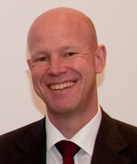
Mr. Thomas Homberg
Corporate Vice President, Head of EADS Strategic Coordination
In my presentation I will first refer to the trend of increasing convergence between defense and security within the current and future threat environment. Second, I will focus on some consequences for industry, government, and our military forces, including options to more efficiently respond to evolving threats.
THE CHALLENGES WE FACE
Today we face particular challenges in light of the pressure on public finances due to the economic crisis. In parallel we must enhance the effectiveness of our forces and also respond to new security requirements.
We face a complex and diverging array of threats. These threats include classic, high-intensity conflict scenarios as well as asymmetric threat scenarios such as those in Afghanistan, which require situational awareness, aggression deterrence, camp/convoy and soldier protection, counter-IED technologies, and precision engagement. Finally, these threats comprise new challenges such as energy security and cyber security, to name two.
This complexity and divergence of threats is driving convergence between defense and security on at least four levels:
1. Convergence is occurring at an operational level, in operations abroad and domestically.
When operating in the same environment, it is critical to ensure interoperability between all actors in theatre, be they defense or police forces or civil agencies, in order to ensure seamless operations. This interaction must also materialize in training and preparation. Regular contact between the U.S. Marine Corps and the International Medical Corps was highlighted in an earlier panel, and this is a good example of ensuring seamless operations in theatre via adapted preparation.
In addition, cooperation between security and armed forces engenders domestic security. The deployment of Eurofighters for air policing missions during the European Football Championship in Austria in 2008 is just one of many examples of such cooperation.
2. As a result of the operational continuum, we see convergence at a conceptual level.
A report by the group of experts led by Madeleine Albright on the new NATO Strategic Concept highlights the importance of a comprehensive approach that combines military and civilian elements to execute operations. Equally, it is part of the priorities of the European Defense Agency’s capability strategy to develop interoperability between armed forces, police forces, and civilian actors.
3. Defense and security could be more tightly integrated within budgets.
Substantial defense budget cuts are envisaged in almost all European countries. Nevertheless, the current threat perception requires further investment in our defense forces as well as in domestic security for critical infrastructure protection, transportation, and border security. Consequently, policy-makers should attempt to eliminate budget fragmentation and duplication.
4. The commingling of defense and security within budgets drives convergence on the technological level.
Dual use should be applied across different operational domains, not only because of budget reasons to exploit benefits of scale and scope but because emerging security and defense requirements allow us to do so. One example: UAV or mission aircraft with adaptable mission systems can equally detect targets in theatre, survey green or blue borders in border protection systems, increase situational awareness during events like the Olympic Games, and identify pollution within open waters by oil-dumping ships in the Baltics.
SUGGESTED APPROACHES
I suggest that we pursue two related paths regarding these points: a) Foster dual-use technology to maximize economic benefits in the fields of research, development, and procurement, which will b) Enable improved interoperability between security and defense forces and, to a lesser extent, with civil agencies.
Such an approach requires increased commonalities in ConOps, standards, and procedures, and would also lead to further benefits and savings in logistics and maintenance.
THE CONSEQUENCES FOR INDUSTRY AND GOVERNMENTS
I would now like to provide some input on the likely consequences of such an approach for industry and government. Our challenge, as described earlier, is threefold:
1. The complexity of future threats,
2. This is paired with budgetary constraints;
3. Both lead to the before-mentioned convergence.
Such a perspective requires new methods for industry and governments to work together, which we recognized quite some time ago. However, implementation is still a challenge. Although governments are currently making important budget decisions and defining future capabilities, there is an opportunity to better define cooperation between industry and governments. What is required to get it right?
THE NEED FOR COOPERATION AND DISCUSSION
We need more international cooperation and further integration at both the policy and the industrial levels, instead of the rather disconnected approach observed today. Such a request has been raised during all panels held at this conference.
In addition to improved international coordination, we need a straightforward, honest, and constructive interface between industry, governments, and operational forces through the phases of design, development, and procurement. Here, I stress four factors:
1. In design and development, we should refrain from overcustomization and overspecification, which often result in program complexity, cost overruns, and delays.
2. Governments should increasingly favor a “spiral development” approach. Industry should deliver basic product or system configurations that are deployed quickly to theatre and then adapted according to lessons learned. This requires industry to improve its capabilities in rapid prototyping and modifications.
3. The acquisition process should become more flexible and faster. An example is the France-United Kingdom MoU for procurement in cases of urgent operational requirements. Something similar, the “Einsatzbedingter Sofortbedarf,” has been successful in Germany.
4. To ensure faster and more efficient development cycles, industry needs early access to defense and security planners, concepts, and lessons learned.
CONCLUDING REMARKS
When tackling the question “How can industry better support?” I think contractors understand the requirements and opportunities, including those driven by the convergence of defense and security. There are several possible ways forward, some of which I have tried to summarize. What we do not do is “walk the talk.” Our forces deserve it.
|

